 |
| Juan de Mesa, Saint Raymond Nonnatus Spanish, 1626 Seville, Museo de Bellas Artes de Sevilla |
Anyone who has watched the long-running BBC television series, “Call the
Midwife”, knows that it is about the memories of the young women who worked as
nurse-midwifes in the East End of London during the late 1950s and into the 1960s. They also know that these young
women live together in the convent of a group of Anglican nuns.
We are told in the very first episode that
the nuns belong to a nursing order of sisters “the Sisters of Saint Raymond Nonnatus,
midwives and district nurses”.1 However, the actual name of the sisters with whom
Jennifer Worth, the author on whose memoirs the series is based, lived is the
still existing order of the Sisters of St. John the Divine. Though greatly shrunken in numbers, they are
currently based in Birmingham, West Midlands, UK.
When I originally saw “Call the Midwife” I assumed that the
producers had decided to make up a name for the order, using a completely
fictitious saint name. I had never heard
of a Saint Raymond Nonnatus who was the patron saint of childbirth and
midwives. I was completely wrong. Saint Raymond Nonnatus may be overshadowed by
other saints also named Raymond, but he is very, very real indeed. In fact, I already knew more about his life
than I thought, in spite of the fact of not having ever heard of him.
In spite of his name, which means “not born” (non natus), Raymond Nonnatus was born in
Portello, in Catalonia, in the kingdom of Aragon in northeastern Spain, around
the year 1200. Like Julius Caesar he was
born through an incision in his mother, that is by caesarian section, when she
died during childbirth. Hence his odd
descriptive name, for he was not born in the usual manner. Presumably this indicates that he may have
been of noble birth, as this procedure was more likely to have been employed for a noble in this kind of situation, but this is not certain.
As a young man he joined the newly founded Order of the Blessed Virgin
Mary of Mercy of the Redemption of Captives, known as the Mercedarians.
It is through this connection that I was aware of at least some parts of
his story, for the Mercedarians have a long history in Spain and, consequently,
in the New World. Indeed, the town of Merced
in California is named for them, for they were a well-known order with a past
filled with martyrdom by the time the Americas became part of Spain’s
empire.
 |
| Francisco Pacheco, Mercedarians Ransoming Christian Captives Spanish, c. 1600-1611 Barcelona, Museo de arte de Catalunya |
Founded sometime between 1218 and 1230 2 by Saint Peter
Nolasco, this new order had as its aim the ransom of poor Christians sold into
slavery by the Moors who had occupied much of Spain since the 8th
century.
Spain was divided between the
Christian (Catholic) northern kingdoms and the Moorish (Muslim) emirates of the
south. There was frequent raiding along
the borders between the two as well as raiding along the coasts by North
African Moors. The main aim of the order
was to raise money to ransom the captives seized in these raids.
As with kidnappings today, captives would be held for ransom for some
time after seizure and then, if unable to pay, sold on into slavery in North
Africa. The principal aim of the
Mercedarians was to ransom the poorer Christians, those whose families could not raise enough
money to free them. Their entire purpose
was to free the captives, so they could return to their families in Christian Spain.
Mercedarian friars were sent to deliver the ransoms both inside Spain and across the Mediterranean in North Africa, as required. If they did not have enough money to ransom every captive, they were to offer their own person as a substitute. All friars had to take a fourth vow (in addition to poverty, chastity and obedience) "to visit and to free Christians who are in captivity and in power of the Saracens or of other enemies of our Law… By this work of mercy… all the brothers of this Order, as sons of true obedience, must always be gladly disposed to give up their lives, if it is necessary, as Jesus Christ gave up his for us."3 This left them open to mistreatment, torture and even death as the pirates and slave traders reacted to the loss of their "stock".
Mercedarian friars were sent to deliver the ransoms both inside Spain and across the Mediterranean in North Africa, as required. If they did not have enough money to ransom every captive, they were to offer their own person as a substitute. All friars had to take a fourth vow (in addition to poverty, chastity and obedience) "to visit and to free Christians who are in captivity and in power of the Saracens or of other enemies of our Law… By this work of mercy… all the brothers of this Order, as sons of true obedience, must always be gladly disposed to give up their lives, if it is necessary, as Jesus Christ gave up his for us."3 This left them open to mistreatment, torture and even death as the pirates and slave traders reacted to the loss of their "stock".
This was the Order into which young Raymond Nonnatus entered as one
of its earliest novices. Because its
original concept derived from the orders of Crusader knights (Hospitallers or
Templars) most of the Mercedarians were lay brothers, not priests. However, some men were chosen to study for
ordination in order to enable the order to have its own priests. Raymond Nonnatus was one such, being ordained
in 1222. He was also one of the men
chosen for the hazardous position of Redeemer.
This is the title for those brothers sent across the borders to personally redeem groups of
captives (individual redemptions appear to have been handled mostly by
intermediaries).
Raymond appears to have gone on several such
trips: in 1224, 1229 and 1232. However,
on his final trip, in 1236 to Algiers, he was cruelly tortured. On this occasion, he did not have enough
funds to finance all the necessary redemptions so, in order to ransom at least
one more person, he gave himself up in place of another.
While in captivity, he offered support to his fellow captives and attempted to preach Christianity to the Muslim guards. In retaliation for his preaching, his captors pierced his upper and lower lips and inserted a padlock to stop him from speaking. The padlock was removed each day only for as long as it took him to eat. He remained in this condition for eight months, until he himself was redeemed from captivity.4
While in captivity, he offered support to his fellow captives and attempted to preach Christianity to the Muslim guards. In retaliation for his preaching, his captors pierced his upper and lower lips and inserted a padlock to stop him from speaking. The padlock was removed each day only for as long as it took him to eat. He remained in this condition for eight months, until he himself was redeemed from captivity.4
Following his return to Spain, he was elevated to the status
of Cardinal by Pope Gregory IX, who also called him to come to Rome. On his
way to Rome, Raymond fell ill in the Aragonese town of Cardona and died there
on August 31, 1240, which became his feast day. He was beatified in
1627 and canonized in 1657 by Pope Alexander VII. He is the patron saint of childbirth, of
pregnant women and newborn babies, as well as of professions that require
secrecy.5
Iconography of St. Raymond Nonnatus
The iconography of St. Raymond Nonnatus ranges from the
historical to the imaginative.
Primarily, it begins to appear in the seventeenth century, when he was
first beatified. It is historical or at
least historical as much as the seventeenth-century was historical in its art. Some fabulous elements did appear, such as
the miraculous feeding of the infant Saint Raymond by angels, but in the main his
iconography remained primarily in the historical dimension.
Many of the paintings of St. Raymond Nonnatus come from two
important building projects undertaken by the two branches of the Mercedarian
order during the first half of the seventeenth century in Spain.
In the beginning of the century the Mercedarians of Seville constructed a monastery (today the Museo de Bellas-Artes de Sevilla) and dedicated the decorations to the memory of their founder and his early disciple. Most of the images reference the life of Saint Peter Nolasco, but many also record the stories of Saint Raymond Nonnatus. The paintings are primarily the work of Francisco Pacheco, who is chiefly remembered today as the teacher of his far greater pupil (and son-in-law), Diego Velazquez. These pictures focus primarily on his life, although occasionally imaginative touches are included.
In the beginning of the century the Mercedarians of Seville constructed a monastery (today the Museo de Bellas-Artes de Sevilla) and dedicated the decorations to the memory of their founder and his early disciple. Most of the images reference the life of Saint Peter Nolasco, but many also record the stories of Saint Raymond Nonnatus. The paintings are primarily the work of Francisco Pacheco, who is chiefly remembered today as the teacher of his far greater pupil (and son-in-law), Diego Velazquez. These pictures focus primarily on his life, although occasionally imaginative touches are included.
.jpg) |
| Francisco Pacheco, Apparition of the Virgin Mary to the Young Raymond Nonnatus Spanish, c. 1600-1611 Seville, Museo de Bellas Artes |
 |
| Francisco Pacheco, Last Communion of Saint Raymond Nonnatus Spanish, 1611 Barnard Castle, Co. Durham, UK, Bowes Museum |
Closer to the middle of the century, the Discalced (sandal
wearing) Mercedarians, also in Seville, commissioned the great artist, Francisco
Zurbaran, to decorate their new monastery.
His breathtaking paintings of Saint Peter Nolasco, now in the Prado, are well known, while those of Saint Raymond Nonnatus are not, partly because they are now in private collections and are represented by very indifferent old photographs.
 |
| Francisco de Zurbarán, Saint Raymond Nonnatus Spanish, c. 1636-1641 Private Collection |
 |
| Francisco de Zurbaran, Saint Raymond Nonnatus Crowned by Christ Spanish, c. 1636-1541 Private Collection |
Other painters also contributed to the formation of an
iconography of St. Raymond, by reflection on the life and sanctity of the man,
so that by the end of the eighteenth century his attributes were pretty well
fixed. Among them are the martyr’s palm
encircled by three crowns which represent the Apostolic Counsels of poverty,
chastity and obedience which he had vowed as a religious, his white Mercedarian
habit, with the red and white shield shaped pendant that is the symbol of the
order, and sometimes partial application of the red clothing of a Cardinal.
Vicente Carducho, Martyrdom of Saint Raymond Nonnatus
Spanish, c. 1600-1630
Madrid, Museo Nacional del Prado
 |
| Carlo Saraceni, Sermon of Saint Raymond Nonnatus Italian, c. 1612-1614 Rome, Curia Generalizia of the Mercedarians |
 |
| Antonio del Castillo, Saint Raymond Nonnatus Spanish, c. 1640-1650 Zaragoza, Museo Goya |
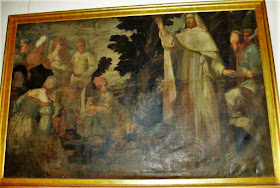 |
| Anonymous, Saint Raymond Nonnatus Preaching Spanish, c.1650 Real Monasterio de El Puig de Santa Maria |
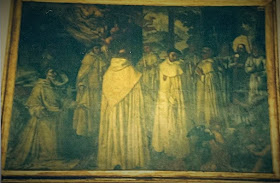 |
| Pablo Pontons, Last Communion of Saint Raymond Nonnatus Spanish, c.1650 Real Monasterio de El Puig de Santa Maria |
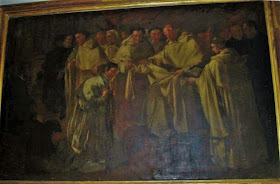 |
| Pablo Pontons, Presentation of the Mercedarian Habit to Saint Raymond Nonnatus Spanish, c. 1650 Valencia, Museo de Bellas Artes |
 |
| Diego Gonzalez de la Vega, Saint Raymond Nonnatus Crowned by Christ Spanish, 1673 Madrid, Museo Nacional del Prado |
 |
| Jeronimo Jacinto Espinosa, Saint Raymond Nonnatus Spanish, 17th century Madrid, Museo del Prado |
 |
| Jose Vergara Gimeno, Saint Raymond Nonnatus Spanish, c.1750 |
Because of the circumstances of his birth, Saint Raymond Nonnatus has long been considered a patron saint of childbirth and protector of both expectant mothers and newborn children,
 |
| Francisco de Zurbarán, A Young Mother Praying to Saint Raymond Nonnatus for Her Newborn Spanish, c. 1636-1641 Private Collection |
He remains better known in the Spanish speaking world, including the Americas, than among English speakers, which is probably not surprising, and his veneration
is very much alive today.
,%20c.%201800_Guatemala%20City,%20Church%20of%20Santa%20Rosa.jpg) |
| Anonymous, Saint Raymond Nonnatus Spanish Colonial (Guatemala), c. 1800 Guatemala City, Church of Santa Rosa |
,%20c.%201800_Washington,%20Smithsonian%20American%20Art%20Museum.jpg) |
| Felipe de la Espada, Saint Raymond Nonnatus American (Puerto Rico), c. 1800 Washington, Smithsonian American Art Museum |
_c.1820-35_Philadelphia_MofA.jpg) |
Jose Aragon, Saint Raymond Nonnatus American (New Mexico), c.1820-1835 Philadelphia, Museum of Arts |
One of the most interesting aspects of this are the offerings to him at the Municipal Cathedral in Mexico City, where his martyrdom has not been forgotten. A collection of padlocks honors his suffering and represents the hope of the faithful that he will help them with whatever secrets they are carrying.
 |
| Offerings of Padlocks, Altar of Saint Raymond Nonnatus Mexican, 2010 Mexico City, Metropolitan Cathedral |
© M. Duffy, 2016, additional material added 2022
_______________________________________________________
- Call the Midwife, Series 1, Episode 1.
- The difference in dates is the spread between the traditional date of the foundation by Peter Nolasco and the first appearance of documentary evidence for it. The true date is likely to be somewhere between. In any event, Raymond Nonnatus would appear to have been and very early member of the order. See Brodman, James William. Ransoming Captives in Crusader Spain: The Order of Merced on the Christian-Islamic Frontier, University of Pennsylvania Press, 1986. Also available online ©1998 by James William Brodman on The Library of Iberian Resources Online at http://libro.uca.edu/rc/captives.htm
- . This fourth vow has given the order a large number of martyrs over time, including 19 Spanish Mercedarians who were beatified on October 13, 2013 in Tarragona, Spain. They were killed in 1936, during the Spanish Civil War, which unleashed savage attacks on the Church. The attacks not only killed priests and laity, but included the destruction of a great deal of the art kept in churches. See reference on this blog at http://imaginemdei.blogspot.com/2015/09/day-one-new-york.html and at http://orderofmercymen.org/tag/martyrs
- Devesa, Fr. Juan, O de M. Saint Raymond Nonnatus, trans. Colette Joly Dees, Mercedarian Press, LeRoy, NY, 1997, available at http://orderofmercy.org/assets/docstraymond.pdf See also, Brodman, James William. Ransoming Captives in Crusader Spain: The Order of Merced on the Christian-Islamic Frontier, University of Pennsylvania Press, 1986. Also available online ©1998 by James William Brodman on The Library of Iberian Resources Online at http://libro.uca.edu/rc/captives.htm
- Olson-Rudenko, Jennifer. Francisco de Zurbaran’s Paintings for the Calced and Discalced Mercedarians of Seville, Doctoral Dissertation in Art History in the Pennsylvania State University Graduate School College of Arts and Architecture, May 2011. Available at https://etda.libraries.psu.edu/catalog?f%5Bkeyword_ssim%5D%5B%5D=FRANCISCO+DE+ZURBAR%C3%81N&f%5Blast_name_ssi%5D%5B%5D=Olson-Rudenko




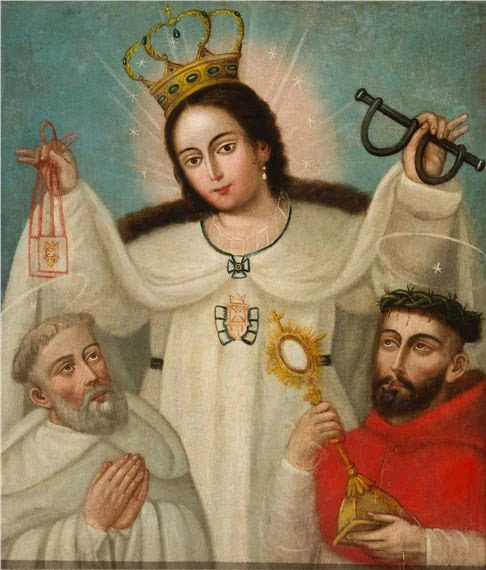










.jpg)











,%20c.%2011th%20-%2012th%20Century_Paris,%20Bibliotheque%20nationale%20de%20France_MS%20Latin%20790,%20fol.%201r.jpg)

,%20First%20half%20of%20the%2014th%20Century_Baltimore,%20Walters%20Art%20Museaum_MS%20W148,%20fol.%2021v%20(2).jpg)








,%20c.%201300_The%20Hague,%20KB_MS%20KB%2071%20A%201,%20fol.%208r%20(2).jpg)
,%20Beginning%20of%20the%2015th%20Century_Paris,%20BNF_MS%20Francais%20242,%20fol.%20189r.jpg)




,%20c.%201503-1508_Paris,%20BNF_MS%20Latin%209474,%20fol.%20181v.jpeg)









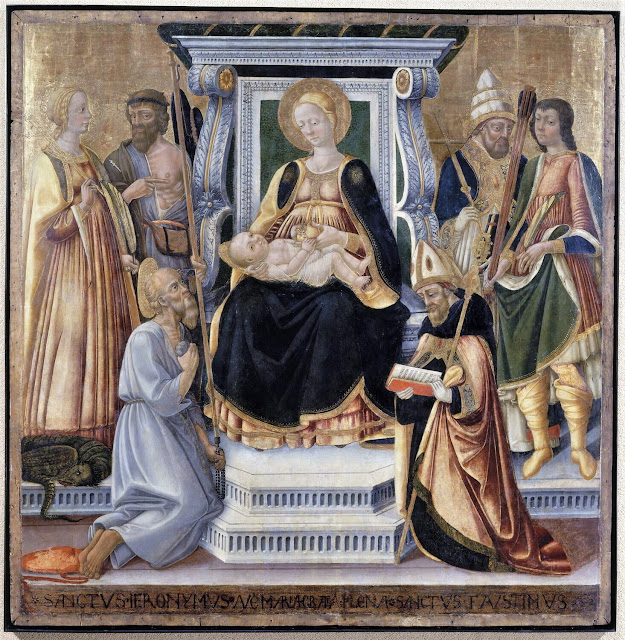










,%201409_Paris,%20BNF_MS%20Latin%20919,%20fol.%2093r.jpg)
Parable%20of%20the%20Trinity,%20S.%20Gimignano,%20S.%20Agostino,%201464-65.jpg)













,%20c.%201445-1460_Paris,%20Bnf_MS%20Latin%209473,%20fol.%20164v.jpg)






,%20c.%201450-1460_The%20Hague,%20KB_MS%20KB%2076%20F%202,%20fol.%20266v.jpg)
,%20c.%201470-1480+P,%20BNF_MS%20Francais%2017,%20fol.311r.jpeg)

,%20c.%201500-1510_The%20Hague,%20KB_%20MS%20KB%2071%20G%2053,%20fol.%2087v.jpg)




_French_Paris_1469-1473_BNF_Francais%2018_fol.%2023r.jpeg)
,%20c.%201470-1480+P,%20BNF_MS%20Francais%2017,%20fol.%20111r.jpeg)






